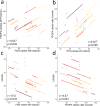Longitudinal trimodal imaging of midbrain-associated network degeneration in Parkinson's disease
- PMID: 35732679
- PMCID: PMC9218128
- DOI: 10.1038/s41531-022-00341-8
Longitudinal trimodal imaging of midbrain-associated network degeneration in Parkinson's disease
Abstract
The prevailing network perspective of Parkinson's disease (PD) emerges not least from the ascending neuropathology traceable in histological studies. However, whether longitudinal in vivo correlates of network degeneration in PD can be observed remains unresolved. Here, we applied a trimodal imaging protocol combining 18F-fluorodeoxyglucose (FDG)- and 18F-fluoro-L-Dopa- (FDOPA)-PET with resting-state functional MRI to assess longitudinal changes in midbrain metabolism, striatal dopamine depletion and striatocortical dysconnectivity in 17 well-characterized PD patients. Whole-brain (un)paired-t-tests with focus on midbrain or striatum were performed between visits and in relation to 14 healthy controls (HC) in PET modalities. Resulting clusters of FDOPA-PET comparisons provided volumes for seed-based functional connectivity (FC) analyses between visits and in relation to HC. FDG metabolism in the left midbrain decreased compared to baseline along with caudatal FDOPA-uptake. This caudate cluster exhibited a longitudinal FC decrease to sensorimotor and frontal areas. Compared to healthy subjects, dopamine-depleted putamina indicated stronger decline in striatocortical FC at follow-up with respect to baseline. Increasing nigrostriatal deficits and striatocortical decoupling were associated with deterioration in motor scores between visits in repeated-measures correlations. In summary, our results demonstrate the feasibility of in-vivo tracking of progressive network degeneration using a multimodal imaging approach. Specifically, our data suggest advancing striatal and widespread striatocortical dysfunction via an anterior-posterior gradient originating from a hypometabolic midbrain cluster within a well-characterized and only mild to moderately affected PD cohort during a relatively short period.
© 2022. The Author(s).
Conflict of interest statement
The authors declare no competing interests.
Figures





References
Grants and funding
LinkOut - more resources
Full Text Sources

